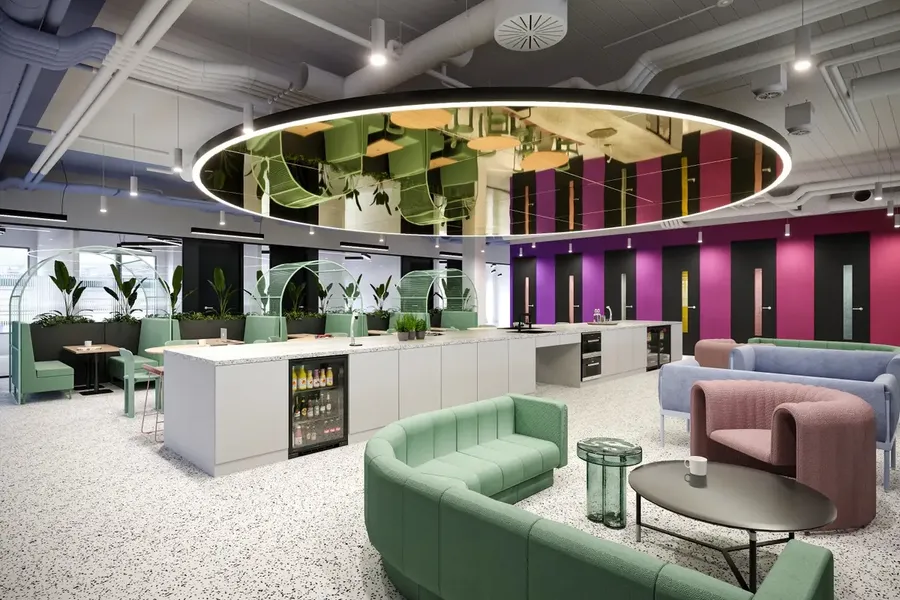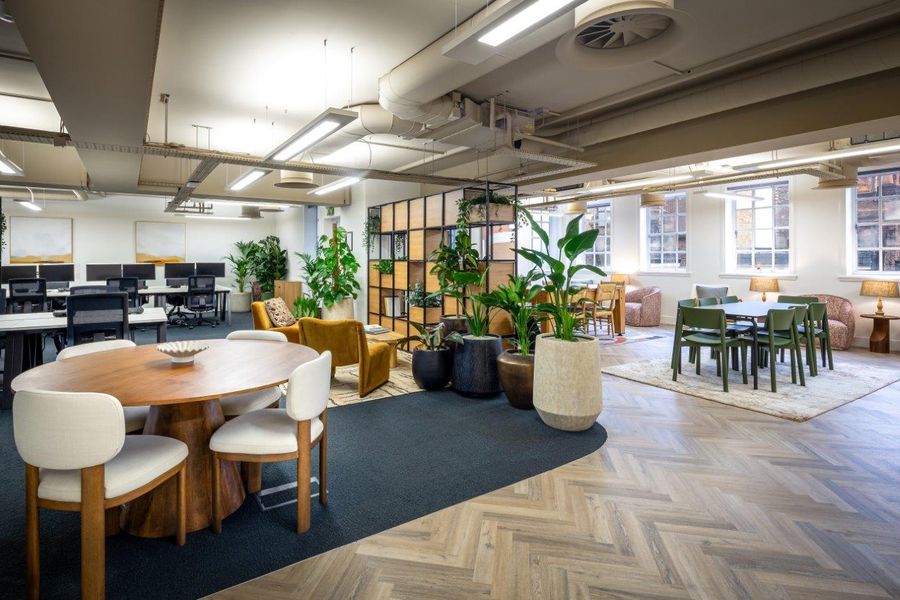Managed Office Space: Managed vs Serviced vs Leased

 Rishita
RishitaRishita
19th Aug 2025
🕰️ 6 min read (1,183 words)
The days of signing a 10-year lease and custom-fitting an empty office are gradually coming to an end. Today’s occupiers want flexibility, speed, and service. For landlords and investors, understanding the nuances of managed, serviced, and leased offices has become essential to capturing demand. To summarise:
- Managed Offices: Privately branded spaces tailored to tenants’ needs, operated by a provider, offering a balance of flexibility and control.
- Serviced Offices: Fully furnished, plug-and-play workspaces, all-inclusive monthly fees, prioritising speed and flexibility.
- Leased Offices: Full control over design, operations, and branding, suited for established businesses seeking long-term value.
This article explores each model, how they operate, their typical costs, facilities, levels of customisation, and the types of businesses they suit. Drawing on market data and workplace trends, it helps decision-makers navigate today’s office landscape with confidence.
The Market Context: A Fundamental Restructuring
 (1)-900x601.jpg)
Hybrid work has reshaped demand. By early 2025, 28% of UK working adults were using some form of hybrid arrangement. This shift has driven interest in offices that can adapt quickly to changing company needs.
Vacancy data, however, underlines the complexity of the market. Central London’s overall vacancy rate hit 10.6% in 2025, nearly double pre-pandemic levels, yet top Grade A properties still command rents up to £160 per square foot in the West End. This “flight to quality” shows that businesses are willing to pay more for exceptional space, while expecting landlords to deliver flexibility alongside it.
UK landlords anticipate 54% growth in demand for flexible/coworking workspace by 2030
Managed

Managed offices offer dedicated, privately branded spaces designed to tenant specifications but operated by the provider. Contracts typically run 12–36 months. Costs sit between serviced and leased offices, as providers fund fit-outs upfront and recover them through contracts.
Customisation & Branding
High tenants work with the provider to choose layouts, lighting design, signage, brand colours, furniture, and IT infrastructure.
Facilities & Services
Similar to serviced (meeting rooms, reception, breakout areas), but often tailored to reflect company identity.
Costs
Moderate monthly fee; fit-out included in contract, improving cost predictability. Paid quarterly in many cases.
Exit Strategy
Medium flexibility. Longer notice periods (several months) and possible exit fees.
Privacy & Security
Dedicated, controlled-access environment, suitable for businesses handling client data.
Provider/Landlord Role
Provider manages facilities and operations; tenants shape design and IT setup.
Best Suited For
SMEs scaling up or down, companies seeking a balance between flexibility and brand identity, and businesses avoiding the high financial risk of a lease.
✅ Advantages
- Private and branded space
- Exclusive use
- Moderate contract length
- Facilities included
❌ Disadvantages
- More expensive than leasing
- Less flexible than serviced
- No full autonomy.
Serviced

Serviced offices are plug-and-play, furnished workspaces offered on monthly rolling contracts. The all-inclusive licence fee typically covers rent, IT infrastructure, utilities, cleaning, reception services, and shared facilities.
They are ideal for startups, project teams, and firms entering new markets. Anyone needing speed, zero upfront costs, and minimal operational responsibility.
Customisation & Branding
Minimal signage or furniture tweaks allowed, but no major fit-out or colour scheme changes.
Facilities & Services
Shared breakout spaces, furnished meeting rooms, on-site showers, bike storage, gyms or wellness studios, and networking events are often included.
Costs
Higher per-desk fee (London avg. £625/month, Manchester £379, Birmingham £370). Predictable cash flow, no fit-out expenditure.
Exit Strategy
High flexibility. Tenants can often leave with just 1 month’s notice.
Privacy & Security
Shared access and IT infrastructure may limit suitability for sensitive industries.
Provider/Landlord Role
Operator handles all daily operations, maintenance, and services.
Best Suited For
Startups, SMEs with uncertain growth stage, innovation hub tenants, and overflow space needs.
✅ Pros
- Speed to move in
- No upfront costs
- Monthly rolling contracts
- Built-in community
❌ Cons
- Limited autonomy
- Shared facilities
- Long-term cost
Leased

Leased offices give tenants full autonomy over space design, IT systems, and operations. They carry the highest upfront costs but the lowest long-term rent per sq ft, making them the best option for stable, mature businesses with predictable growth.
Customisation & Branding
Unlimited bespoke fit-outs, structural changes, custom-built layouts, and proprietary IT.
Facilities & Services
Tenant responsibility, meeting rooms, gyms, or eco-friendly designs must be self-funded.
Costs
Prime Central London rents £75 - £100 per sq ft (top assets £115) according to Area's London office market analysis. High deposits, fit-out, business rates, service charges, furniture purchases, and dilapidations at lease end.
Exit Strategy
The least flexible relies on break clauses or subletting. Leases often require restoring space to Cat A condition (“make good”).
Privacy & Security
Maximum. Ideal for firms requiring advanced security systems and confidentiality.
Provider/Landlord Role
Tenant oversees suppliers, operations, and maintenance.
Best Suited For
Large, established firms prioritising stability, full control, and long-term cost efficiency.
✅ Advantages
- Full autonomy
- Branding potential
- Lowest long-term cost
- Strongest privacy/security
❌ Disadvantages
- High upfront capital expenditure
- Long-term contractual commitment
- Operational responsibility
Flexibility vs. Control
These office types form a spectrum of trade-offs:
- Serviced: Maximum speed and flexibility, minimum control.
- Managed: Balance of privacy, branding, and outsourced operations.
- Leased: Maximum control and long-term value, minimum flexibility.
Smart companies evolve their office format as their needs change. Leanspace's unique Fit Out Finance offer aids in developing their workspace, should they choose a leased arrangement.
The Landlord and Investor Perspective

For landlords and investors, the choice of format shapes returns:
- Serviced offices: 30-50% higher desk rents, but high churn and management needs.
- Managed offices: Balanced yields and shorter contracts, with providers funding fit-outs.
- Leased offices: Steady, low-touch income but longer void periods.
London landlords observed up to a 60% reduction in void periods after introducing landlord-fitted, plug-and-play spaces—demonstrating that even minor upgrades, such as Upgrading Office Tea Points, enhanced wiring, or improved HVAC systems, can significantly boost asset performance without requiring extensive refurbishments.
Regional and Global Patterns

London shows the full spectrum: serviced offices command premiums in top-tier locations, while Manchester, Birmingham and Bristol lean toward managed formats, appealing to ambitious but cost-conscious firms. Suburban markets are also growing as hybrid workers seek quality office space closer to home. To keep abreast of uptake trends across regions, explore our article on Office Market Uptake for further details.
Globally, trends vary: in the US, coworking is mature and enterprise-ready, while managed formats are scaling up. Across Europe, hybrids are proliferating in German and Dutch tech hubs. APAC sees serviced and hospitality-led offices dominate, driven by bundled services and new infrastructure.
A Hybrid Future?
Landlords are offering hybrid lease-serviced models, supplementing long contracts with flexible add-on services according to a Property Week Lease Hybridisation report. Short-term day offices are rising as a way to monetise voids and convert users into long-term tenants. Revenue-share and equity-based Fit-Out Finance models are also gaining traction, reducing reliance on traditional bank funding.
Finding and Choosing the Right Office Space
Ultimately, choosing the right office is not just about rent. Budget constraints, commuting distances, eco-friendly designs, employee wellbeing, collaboration spaces, and team culture all shape the decision. Aligning workspace strategy with growth projections and choosing the right workspace provider is important.


